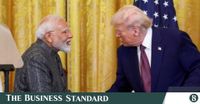In a dramatic turn for global trade, India is bracing for the impact of sweeping new tariffs imposed by the United States, a move that has sent shockwaves through both the business world and political corridors. At the heart of this brewing economic storm is a 50% tariff on Indian goods—one of the highest ever levied by the US on any trading partner. The announcement, made by President Donald Trump and effective August 28, 2025, is intended as a penalty for India’s continued purchase of Russian oil, following months of failed trade negotiations between the two nations.
As reported by Reuters and the Economic Times India, the breakdown in talks stemmed from disagreements over opening India’s vast farm and dairy sectors and halting Russian oil imports. With the US making up roughly 18% of India’s exports and 2.2% of its GDP, the stakes could hardly be higher. Some industries—especially textiles, chemicals, and auto parts—send up to 40% of their goods to the US, making them particularly vulnerable to the new tariffs.
Prime Minister Narendra Modi responded with a firm message to his country’s rural heartland. Speaking at an event in New Delhi, he declared, “For us, our farmers’ welfare is supreme. India will never compromise on the well-being of its farmers, dairy [sector] and fishermen. And I know personally I will have to pay a heavy price for it.” While Modi did not directly mention the US or the failed trade talks, his remarks made clear that protecting domestic agriculture remains a non-negotiable priority—even at significant economic cost.
India’s foreign ministry echoed this sentiment, calling the US decision “extremely unfortunate” and vowing to “take all necessary steps to protect its national interests.” The message was unmistakable: India will not back down, even as it faces what analysts at Nomura have likened to a “trade embargo” in terms of the potential damage to Indian exporters.
At the BT India@100 summit on August 9, 2025, Deloitte South Asia CEO Romal Shetty offered a grounded yet optimistic perspective on the crisis. In conversation with Business Today, Shetty emphasized that “innovation thrives under constraint” and noted that India has a long history of excelling in tough environments. He cautioned against the volatility and unpredictability of global tariffs but saw the situation as a catalyst for Indian industry to expand into new markets, particularly in the Global South, and to rethink its trade strategies. “This is a time for calm confidence,” Shetty advised, suggesting that adversity could ultimately spark a new wave of Indian ingenuity.
Still, the immediate risks are hard to ignore. According to Emkay Global’s Seshadri Sen, “This is a tough time for investors, and many are unsure about how the situation will develop.” The new tariffs will make Indian goods more expensive in the US, threatening to halt exports from sectors that already operate on razor-thin margins. The textile industry, with major players like Gokaldas and Kitex, is particularly exposed. Chemicals companies such as Camlin, Aarti, and Atul, as well as auto parts manufacturers like BHFC, Suprajit, and Sona BLW, also face significant headwinds.
The effects are not limited to exporters. Indian companies that sell American brands domestically—such as Jubilant Foodworks (which operates Domino’s and Dunkin’ Donuts), Devyani International (Burger King), and Varun Beverages (Pepsi)—may experience a short-term drop in business if public sentiment swings towards boycotting US products in favor of Indian-made alternatives. Some experts warn that a wave of consumer nationalism could further complicate the business landscape.
In response to these challenges, analysts at SBI Securities are recommending a strategic pivot. They advise investors to focus on sectors that rely more heavily on Indian consumers, such as cement, telecom, hospitals, railways, and alcoholic beverages. This shift could help insulate the Indian economy from global shocks, at least in the short term.
There is, however, a silver lining for exporters: the recent decline in the value of the Indian rupee. While a weaker currency presents its own challenges, it also makes Indian goods cheaper for overseas buyers, potentially offsetting some of the pain from higher tariffs. As Ajay Sen of Emkay Global noted, “If the market drops more than 5%, it could be a good time to invest.” Some experts see the current volatility as an opportunity for long-term investors to buy quality stocks at a discount—provided they have the stomach for risk.
Not all sectors are equally affected. Key industries like information technology, pharmaceuticals, and electronics remain largely insulated from the new tariffs, offering a degree of stability amid the turbulence. Dr. VK Vijayakumar of Geojit Financial Services urged caution but reassured that “the market will not panic,” highlighting the resilience of these sectors as a buffer against broader economic shocks.
Despite the uncertainty, there is a sense that Indian enterprise is poised to adapt and even thrive in the face of adversity. As Romal Shetty observed at the BT India@100 summit, “India has historically excelled in tough environments.” This sentiment is echoed by many business leaders who see the current crisis not just as a threat, but as an opportunity to innovate, diversify, and build new trade relationships beyond the US.
With 21 days remaining before the tariffs are set to take effect, the mood in India is a mix of anxiety and determination. Investors and industry leaders are watching closely, weighing their options and preparing for what could be a prolonged period of adjustment. For the government, the challenge will be to balance the defense of domestic interests—especially those of farmers and rural communities—with the need to maintain economic growth and global competitiveness.
As the world’s largest democracy navigates this period of heightened trade tensions, one thing is clear: India’s response will be shaped by a blend of pragmatism, resilience, and an unwavering commitment to its national priorities. The coming weeks will test the country’s economic mettle, but if history is any guide, Indian industry is likely to emerge stronger, more innovative, and ready to chart new paths in an unpredictable world.
